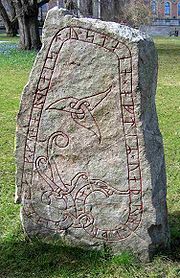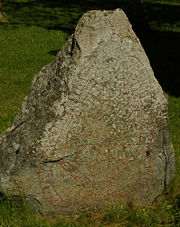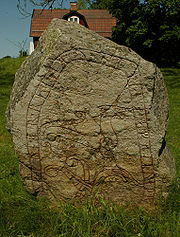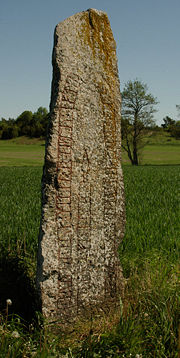
Funbo Runestones
Encyclopedia




Uppland
Uppland is a historical province or landskap on the eastern coast of Sweden, just north of Stockholm, the capital. It borders Södermanland, Västmanland and Gästrikland. It is also bounded by lake Mälaren and the Baltic sea...
, Sweden
Sweden
Sweden , officially the Kingdom of Sweden , is a Nordic country on the Scandinavian Peninsula in Northern Europe. Sweden borders with Norway and Finland and is connected to Denmark by a bridge-tunnel across the Öresund....
, which were raised by members of the same family during the eleventh century.
The following presentations show the runic script transliterated into Latin script, together with transcriptions into the Old West Norse and Old East Norse dialects of Old Norse
Old Norse
Old Norse is a North Germanic language that was spoken by inhabitants of Scandinavia and inhabitants of their overseas settlements during the Viking Age, until about 1300....
and translations into English. The runestones are listed in order of their Rundata
Rundata
The Scandinavian Runic-text Data Base is a project involving the creation and maintenance of a database of runic inscriptions. The project's goal is to comprehensively catalog runestones in a machine-readable way for future research...
catalog listing, chronologically U 999 is the oldest inscription and is followed by U 990 and then the two stones U 937 and U 991.
U 937
The runestone designated as U 937 in the Rundata catalog was found in UppsalaUppsala
- Economy :Today Uppsala is well established in medical research and recognized for its leading position in biotechnology.*Abbott Medical Optics *GE Healthcare*Pfizer *Phadia, an offshoot of Pharmacia*Fresenius*Q-Med...
in 1875 in the walls of a Franciscan
Franciscan
Most Franciscans are members of Roman Catholic religious orders founded by Saint Francis of Assisi. Besides Roman Catholic communities, there are also Old Catholic, Anglican, Lutheran, ecumenical and Non-denominational Franciscan communities....
monastery
Monastery
Monastery denotes the building, or complex of buildings, that houses a room reserved for prayer as well as the domestic quarters and workplace of monastics, whether monks or nuns, and whether living in community or alone .Monasteries may vary greatly in size – a small dwelling accommodating only...
between the streets of St. Persgatan and Klostergatan, and is currently located at a park in Uppsala University
Uppsala University
Uppsala University is a research university in Uppsala, Sweden, and is the oldest university in Scandinavia, founded in 1477. It consistently ranks among the best universities in Northern Europe in international rankings and is generally considered one of the most prestigious institutions of...
. The fact that its inscription mentions names from the same family as the runestones of Funbo, shows that it was formerly part of the same group. Like many other runestones, it had been used as construction material at a time when the historical significance of the stones was not understood. It is considered to be a good example of runestone style
Runestone styles
The runestone styles varied during the Viking Age. The early runestones were simple in design, but towards the end of the runestone era they became increasingly complex and made by travelling runemasters such as Öpir and Visäte....
Pr3, which is also known as the Urnes style
Urnes style
The Urnes style was the last phase of Scandinavian animal art during the second half of the 11th century and in the early 12th century. The preceding phases of Scandinavia's Viking Age animal ornamentation are usually categorized as Oseberg style, Borre style, Jelling style, Mammen style and...
. This runestone style is characterized by slim and stylized animals that are interwoven into tight patterns. The animals heads are typically seen in profile with slender almond-shaped eyes and upwardly curled appendages on the noses and the necks. On this stone the runic text lies within a serpent that circles a triquetra
Triquetra
Triquetra originally meant "triangle" and was used to refer to various three-cornered shapes. Nowadays, it has come to refer exclusively to a particular more complicated shape formed of three vesicae piscis, sometimes with an added circle in or around it...
, which would have been considered a high status motif.
Because the runic text of runestones U 937 and U 991 have the same message, it has been suggested that they were once at the same site and formed a coupled memorial to the deceased brother Veðr. They are considered to be the most recent of the four Funbo inscriptions and, although unsigned, are considered to be the work of the runemaster
Runemaster
A runemaster or runecarver is a specialist in making runestones.Most early medieval Scandinavians were probably literate in runes, and most people probably carved messages on pieces of bone and wood. However, it was difficult to make runestones, and in order to master it one also needed to be a...
Fot
Fot
Fot was a runemaster who flourished in mid-11th century Sweden.-Career:Most early medieval Scandinavians were probably literate in runes, and most people probably carved messages on pieces of bone and wood. However, it was difficult to make runestones, and in order to master it one also needed to...
. He is known for his Urnes style inscriptions and for the consistency of his use of the punctuation mark × between words, as shown in the runic text of this runestone.
Inscription
Transliteration:- × þiak(n) × auk × kunar × raistu × stana × aftiR × uaþr × bruþur sin ×
Old West Norse transcription:
- Þegn ok Gunnarr reistu steina eptir Veðr, bróður sinn.
Old East Norse transcription:
- Þiagn ok Gunnarr ræistu stæina æftiR Veðr, broður sinn.
English translation:
- Thane and Gunnar raised this stone after Veðr, their brother.
U 990
Runestone U 990 has its runic text within a serpent that circles a central Christian crossChristian cross
The Christian cross, seen as a representation of the instrument of the crucifixion of Jesus Christ, is the best-known religious symbol of Christianity...
. It remains in its original location in Funbo. It is composed of granite and is 1.5 meters in height. This stone is classified as being carved in runestone style Fp, which is characterized by runic bands that end with animal heads when seen from above.
Inscription
Transliteration:- uaþr + auk × þakn × auk × kunar + raistu × stain + þana × at × haursa × foþur sin + kuþ hialbi ot hans ×
Old West Norse transcription:
- Veðr ok Þegn ok Gunnarr reistu stein þenna at Haursa, fôður sinn. Guð hjalpi ônd hans.
Old East Norse transcription:
- Veðr ok Þegn ok Gunnarr ræistu stæin þenna at Haursa, faður sinn. Guð hialpi and hans.
English translation:
- Veðr and Thane and Gunnar raised this stone after Haursi, their father. God help his soul.
U 991
Runestone U 991, which is composed of granite and is 1.5 meters in height, consists of runic text within a serpent that circles a central beast. Although having different imagery, it contains the same message in its inscription as U 937. Because they have the same message, it has been suggested that they once formed part of a coupled memorial at the same site to the deceased brother Veðr. These are considered to be the most recent of the four Funbo inscriptions and, although unsigned, are attributed to the runemaster Fot. U 991 is classified as being carved in either runestone style Pr3 or Pr4.U 999
Runestone U 999 has text within a band that ends in a serpent head and was raised by Haursi and his brother after their father. This granite stone is 1.65 meters in height and is considered to have the oldest inscription of the four runestones from Funbo. It is classified as being carved in runestone style Fp.Inscription
Transliteration:- haursi : auk : kitil : raistu : aftir : þekn : faþur : sin : staina : þisa : at : bunta : kuþan : o : funum
Old West Norse transcription:
- Haursi ok Ketill reistu eptir Þegn, fôður sinn, steina þessa, at bónda góðan á Funnum/Fúnum.
Old East Norse transcription:
- Haursi ok Kætill ræistu æftiR Þegn, faður sinn, stæina þessa, at bonda goðan a Funnum/Funum.
English translation:
- Haursi and Ketill raised these stones in memory of Þegn , their father; in memory of the good husbandman of Funnir/Fúnir.

